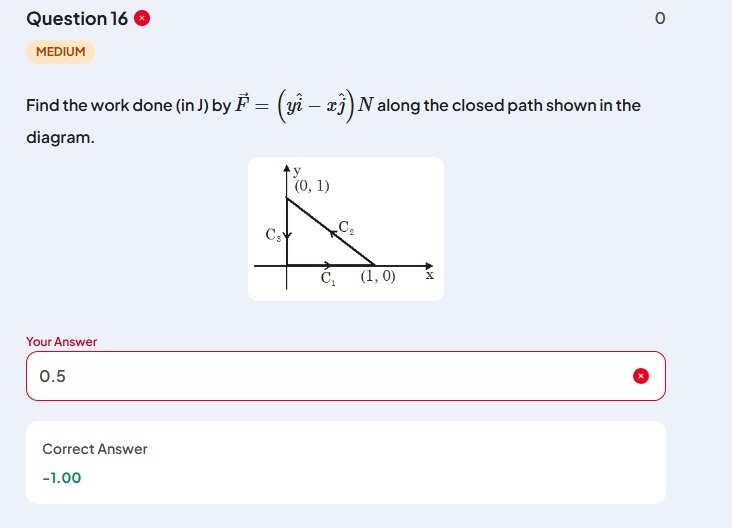Question
Question: Find the work done (in J) by $\overrightarrow{F} = (y\hat{i} - x\hat{j})N$ along the closed path sho...
Find the work done (in J) by F=(yi^−xj^)N along the closed path shown in the diagram.

-1.00
Solution
The work done by the force F=(yi^−xj^) along a path is given by the line integral W=∫CF⋅dr.
Here, dr=dxi^+dyj^. So, F⋅dr=(yi^−xj^)⋅(dxi^+dyj^)=ydx−xdy.
The path is a closed triangle with vertices O(0, 0), A(1, 0), and B(0, 1), traversed in the order O to A (C1), A to B (C2), and B to O (C3).
-
Path C1: From O(0, 0) to A(1, 0). Along this path, y=0 and dy=0. x goes from 0 to 1. W1=∫C1(ydx−xdy)=∫x=0x=1(0dx−x⋅0)=∫010dx=0.
-
Path C2: From A(1, 0) to B(0, 1). This is a line segment connecting (1, 0) and (0, 1). The equation of the line passing through these points is 1x+1y=1, or x+y=1. Thus, y=1−x, and dy=−dx. As we move from A to B, x goes from 1 to 0. W2=∫C2(ydx−xdy)=∫x=1x=0((1−x)dx−x(−dx))=∫10(1−x+x)dx=∫101dx=[x]10=0−1=−1.
-
Path C3: From B(0, 1) to O(0, 0). Along this path, x=0 and dx=0. y goes from 1 to 0. W3=∫C3(ydx−xdy)=∫y=1y=0(y⋅0−0dy)=∫100dy=0.
The total work done along the closed path is the sum of the work done along each segment: W=W1+W2+W3=0+(−1)+0=−1 J.
Alternatively, we can use Green's Theorem. For a force field F(x,y)=P(x,y)i^+Q(x,y)j^, the work done along a positively oriented closed curve C enclosing a region R is given by ∮C(Pdx+Qdy)=∬R(∂x∂Q−∂y∂P)dA.
Here, P(x,y)=y and Q(x,y)=−x.
∂y∂P=∂y∂(y)=1.
∂x∂Q=∂x∂(−x)=−1.
∂x∂Q−∂y∂P=−1−1=−2.
The region R is the triangle with vertices (0, 0), (1, 0), and (0, 1). The area of this triangle is 21×base×height=21×1×1=21.
The work done is ∬R(−2)dA=−2∬RdA=−2×Area(R)=−2×21=−1 J.
The path is traversed in the counterclockwise direction, which is the positive orientation for Green's Theorem.
